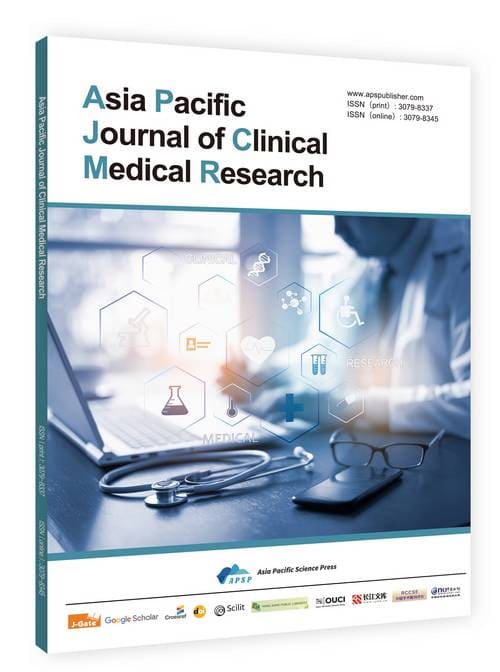Research Progress on Detection Technologies for Pseudomonas aeruginosa
DOI:
https://doi.org/10.62177/apjcmr.v1i3.539Keywords:
Pseudomonas aeruginosa, Detection Technology, Molecular Biology, Immunology, Automated DetectionAbstract
Pseudomonas aeruginosa is an opportunistic pathogen widely distributed in the natural environment, which can cause a variety of infections, especially in people with low immunity and high pathogenicity. In recent years, significant progress has been made in the detection technology of Pseudomonas aeruginosa, covering traditional methods, molecular biology techniques, immunological methods and automated detection systems. Traditional methods such as the national standard method and the filter membrane method are easy to operate, but have the problems of long time consuming and limited sensitivity. Molecular biological techniques (such as PCR, gene cloning) and immunological methods (such as ELISA, colloidal gold immunochromatography) have significantly improved the sensitivity and specificity of detection, but they require high equipment and technology, and are expensive. Automated detection systems, such as VITEK 2 Compact and AutoMS 1000 mass spectrometry identification system, are excellent in improving detection efficiency and accuracy, but their high cost and complex operation process limit their wide application. In addition, the resistance of Pseudomonas aeruginosa to bacteriostatic agents further increases the difficulty of detection. In this paper, the development and application of immunological detection technology, molecular biological technology and immunological technology of Pseudomonas aeruginosa were reviewed, and the principles, advantages, disadvantages and research progress of various detection technologies of Pseudomonas aeruginosa were described, and the future development trend was prospected, in order to provide reference for the optimization and development of detection methods of Pseudomonas aeruginosa.
Downloads
References
Ma, Q., Lin, J. (2011). Microbiological issues existing in the testing methods for drinking natural mineral water as stipulated in GB/T8538-2008. China Health Standard Management, 2(04), 44-47.
Liang, B., Zhao, H., Yan, X., & Sun, L. (2020). Inhibition and effect verification of different disinfectants on microorganisms in bottled drinking water[J].Food Engineering, 2(6), 56-59.
Zhou, H., Zhang, G., Fu, Z., & Xu, W. (2019). Pollution Causes and Detection Methods of Pseudomonas Aeruginosa in Barreled Water[J]. Quality Safety Inspection and Testing, 6(29), 135-137.
Hu, Z., Qiu, H., Chen, Q., Zeng, Y.g, & Yuan, B. (2018). Analysis of test result of Pseudomonas aeruginosa in packaged drinkingwater in Loudi city in 2016~2017[J]. Journal of Food Safety & Quality, 9(6), 1470-1473.
Yang, Y., Du, F., Niu Tao. (2018). Study on the use and quality control of medium in food microbiological examination[J]. Journal of Food Safety & Quality, 9(5), 1055-1058.
Mai, M. (2025). Study on the Critical Control Points and Preventive Measures of Pseudomonas aeruginosa in Barreled Drinking Water by National Standard Filter Membrane Method[J]. China Food Safety Magazine, (03), 183-186.https://doi.org/10.16043/j.cnki.cfs.2025.03.034
Li, J. (2019). Improvement of detection method for pseudomonas aeruginosa in packaged drinking water[J]. Food Engineering, (04), 5-7.
Hu, W., Li, Y., Zhang, X. (2019). MHC-I epitope presentation prediction based on transfer learning[J]. Hereditas(Beijing), 41(11), 1041-1049.https://doi.org/10.16288/j.yczz.19-155
Wu, Q., Han, Q., Zhang, J. (2025). Heart failure complicated with pulmonary infection: Biological functions of Pseudomonas aeruginosa OprF protein and its prokaryotic expression[J]. Chinese Journal of Gerontology, 45(04), 984-987.
Huang, H., Guo, Y., Peng. Q., Lu, Z., Wang, F., Liu, D., Zhang, M. (2025). Rapid detection of Pseudomonas aeruginosa in packaged drinking water using glycosylation functionalized magnetic nanoparticle materials enrichment fluorescence method[J]. Hubei Agricultural Sciences, 64(02), 171-178. https://doi.org/10.14088/j.cnki.issn0439-8114.2025.02.027
Liu, H., Nie, J., Wang, D., Peng, C., Wang Y., Huang, H. (2025). Establishment of Multiplex PCR Detection Method for Five Control Bacteria in Disposable Epidemic Prevention Supplies[J]. China Medical Device Information, 31(01), 53-56. https://doi.org/10.15971/j.cnki.cmdi.2025.01.018
GB 15979-2024. (202Hygiene requirements for single-use hygiene products[S]. 2024.
Yang, C., Yang, Q., Xiang, Y., Zeng, X., Xiao, J., Le, W. (2023). The neuroprotective effects of oxygen therapy in Alzheimer's disease: a narrative review[J]. Neural Regeneration Research, 18(1), 194-199.https://doi.org/10.4103/1673-5374.343897.
Vuorela,A., Freitag, T. L., Leskinen, K., Pessa, H., Härkönen, T., Stracenski, I., Kirjavainen, T., Olsen, P., Saarenpää Heikkilä, O., Ilonen, J., Knip, M., Vaheri, A., Partinen, M., Saavalainen, P., Meri, S., Vaarala, O. (2021). Enhanced influenza A H1N1 T cell epitope recognition and cross-reactivity to protein-O-mannosyltransferase 1 in Pandemrix-associated narcolepsy type 1[J]. Nature Communications, 12(1), 2283-2283.https://doi.org/10.1038/S41467-021-22637-8
Wang, M., Song, H., Cheng, Y., Wang, Y., Yang, B., Hu, Z. (2020). Accurate Detection of Streptococcus pneumoniae by Using Ribosomal Protein L7/L12 as Molecular Marker[J]. China Biotechnology, 40(4), 34-41.https://doi.org/10.13523/j.cb.1910009
Cao, J., Zhu, Y., Hua, M., Liu, S., Yang, B., Hu, Z. (2025). Preparation of colloidal gold immunochromatographic paper for Pseudomonas aeruginosa[J]. Biotechnology, 35(01), 95-101.https://doi.org/10.16519/j.cnki.1004-311x.2025.01.0017
Wan, Y., Shi, Z., Peng, G., Wang, L., Luo, J., Ru, Y., Zhou, G., Ma, Y., Song, R., Yang, B., Cao, L., Tian, H., Zheng, H. (2021). Development and application of a colloidal-gold dual immunochromatography strip for detecting African swine fever virus antibodies[J]. Applied Microbiology and Biotechnology, 106(23), 799-810.https://doi.org/10.1007/S00253-021-11706-Z
Shen, P., Du, Y., Xiao, Y., Lu, F., Lan, L. (2024). Comparative Analysis and Optimization of Detection Methods for Pseudomonas Aeruginosa[J]. Industrial Microbiology, 54(06), 121-123.
Clinical and Laboratory Standards Institute.Performance Standards for Antimicrobial Susceptibility Testing[S]. M100-S32. Wayne, PA:CLSl, 2022.
Lu, D., Shen, Y., Wei, W., Zhou, X., Cao, Y., Pan, Q., Xue, K. (2024). Clinical evaluation for rapid detection of carbapenemase produced by Klebsiella pneumoniae and Pseudomonas aeruginosa using Autof MS 1000 mass spectrometry identification system[J].Chinese Journal of Clinical Laboratory Science, 42(10), 744-747.https://doi.org/10.13602/j.cnki.jcls.2024.10.05
Wu, S., Li, H. (2019). The identification capability and clinical value of a fully automated microbial identification and antimicrobial susceptibility analyzer for pathogenic bacteria[J]. Laboratory Medicine and Clinic, 16(23), 3530-3533.
Downloads
How to Cite
Issue
Section
License
Copyright (c) 2025 Yangke Wang, Dong Liu, Junjie Liu, Baojun Yu, Lingzi Yang

This work is licensed under a Creative Commons Attribution-NonCommercial 4.0 International License.
DATE
Accepted: 2025-08-13
Published: 2025-09-08
















